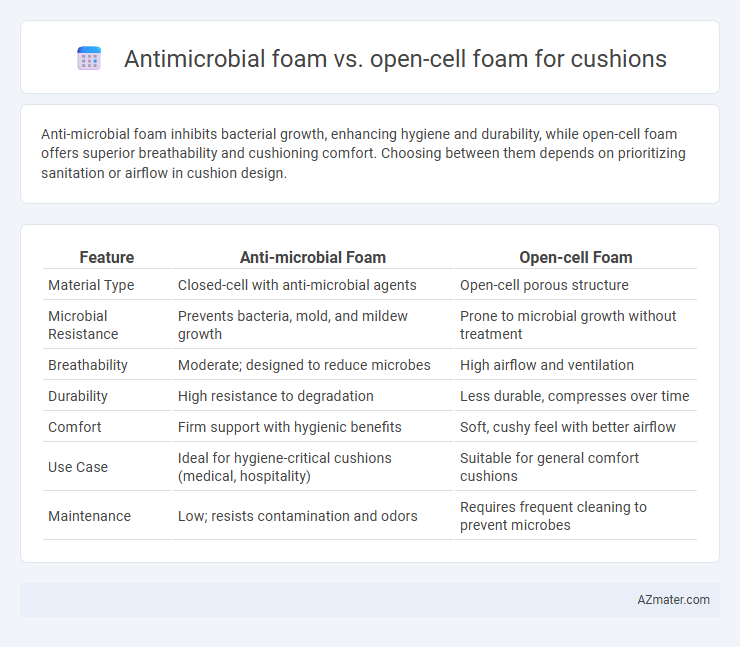Anti-microbial foam inhibits bacterial growth, enhancing hygiene and durability, while open-cell foam offers superior breathability and cushioning comfort. Choosing between them depends on prioritizing sanitation or airflow in cushion design.
Table of Comparison
| Feature | Anti-microbial Foam | Open-cell Foam |
|---|---|---|
| Material Type | Closed-cell with anti-microbial agents | Open-cell porous structure |
| Microbial Resistance | Prevents bacteria, mold, and mildew growth | Prone to microbial growth without treatment |
| Breathability | Moderate; designed to reduce microbes | High airflow and ventilation |
| Durability | High resistance to degradation | Less durable, compresses over time |
| Comfort | Firm support with hygienic benefits | Soft, cushy feel with better airflow |
| Use Case | Ideal for hygiene-critical cushions (medical, hospitality) | Suitable for general comfort cushions |
| Maintenance | Low; resists contamination and odors | Requires frequent cleaning to prevent microbes |
Introduction to Cushion Foam Types
Anti-microbial foam cushions incorporate treatment agents to inhibit the growth of bacteria, mold, and mildew, enhancing hygiene and durability in high-use environments. Open-cell foam is characterized by its porous structure, allowing air circulation and providing a soft, breathable comfort ideal for cushioning applications. Choosing between these foam types depends on specific needs such as infection control or airflow and softness requirements.
What is Anti-Microbial Foam?
Anti-microbial foam is specially treated with agents that inhibit the growth of bacteria, mold, and mildew, making it ideal for cushions used in environments prone to moisture and contamination. Unlike open-cell foam, which features a porous structure and promotes air circulation but lacks inherent resistance to microbial growth, anti-microbial foam enhances hygiene and durability. This foam type is essential for medical, hospitality, and outdoor applications where clean and safe cushioning is critical.
Understanding Open-Cell Foam
Open-cell foam offers superior breathability and flexibility, making it ideal for cushions that require enhanced airflow and comfort. Unlike anti-microbial foam, open-cell foam's porous structure allows moisture to evaporate quickly, reducing the risk of mold and mildew buildup. Its lightweight and soft texture provides cushioning support while promoting a cooler seating experience compared to denser foam types.
Key Differences Between Anti-Microbial and Open-Cell Foam
Anti-microbial foam contains agents that inhibit the growth of bacteria, mold, and mildew, making it ideal for hygienic cushion applications, whereas open-cell foam features a porous structure that enhances breathability and cushioning comfort but lacks inherent antimicrobial properties. The key difference lies in the functional treatment: anti-microbial foam is chemically treated to resist microorganisms, while open-cell foam prioritizes airflow and softness due to its open pore network. Selection depends on whether hygiene control or ventilation and cushioning support is the primary requirement for the cushion.
Durability and Longevity Comparison
Anti-microbial foam offers enhanced durability by resisting mold, mildew, and bacterial growth, extending the cushion's lifespan in humid or high-use environments. Open-cell foam provides excellent breathability and comfort but tends to compress and degrade faster under heavy or continuous use. For long-term structural integrity and hygiene, anti-microbial foam outperforms standard open-cell foam cushions in durability and longevity.
Comfort and Breathability Factors
Anti-microbial foam offers enhanced comfort by preventing bacterial growth, reducing odors, and maintaining hygiene, which is ideal for prolonged cushion use. Open-cell foam excels in breathability due to its porous structure, allowing air circulation that minimizes heat retention and moisture buildup. Combining anti-microbial properties with open-cell foam ensures cushions remain cool, comfortable, and hygienic over extended periods.
Health and Hygiene Benefits
Anti-microbial foam offers superior health and hygiene benefits compared to open-cell foam by inhibiting the growth of bacteria, mold, and mildew, reducing allergens that can trigger respiratory issues. Its closed-cell structure prevents moisture absorption, minimizing the risk of bacterial proliferation and unpleasant odors often associated with traditional open-cell foam. Open-cell foam, with its porous nature, tends to trap dust and microbes, making it less ideal for environments requiring stringent hygiene standards.
Best Applications for Each Foam Type
Anti-microbial foam offers superior resistance to bacteria, mold, and mildew, making it ideal for healthcare settings, gym equipment, and children's cushions where hygiene is paramount. Open-cell foam excels in comfort and breathability, suitable for furniture cushions, mattresses, and soundproofing that require soft support and airflow. Each foam type serves distinct applications based on durability, moisture control, and user comfort needs.
Cost Considerations for Cushion Materials
Anti-microbial foam typically incurs higher initial costs compared to open-cell foam due to specialized chemical treatments that inhibit microbial growth and enhance durability. Open-cell foam, valued for affordability and breathability, offers a cost-effective solution but may require more frequent replacement in high-moisture or hygiene-sensitive environments. Budget allocations should consider long-term maintenance expenses and potential health benefits when selecting between antimicrobial and open-cell foams for cushion materials.
Choosing the Right Foam for Your Cushion Needs
Anti-microbial foam provides enhanced protection against bacteria, mold, and odors, making it ideal for cushions in high-traffic or moisture-prone environments. Open-cell foam offers superior breathability and softness, promoting comfort and airflow but lacks inherent antimicrobial properties. Selecting the right foam depends on balancing durability and hygiene needs against comfort and ventilation preferences.

Infographic: Anti-microbial foam vs Open-cell foam for Cushion
 azmater.com
azmater.com